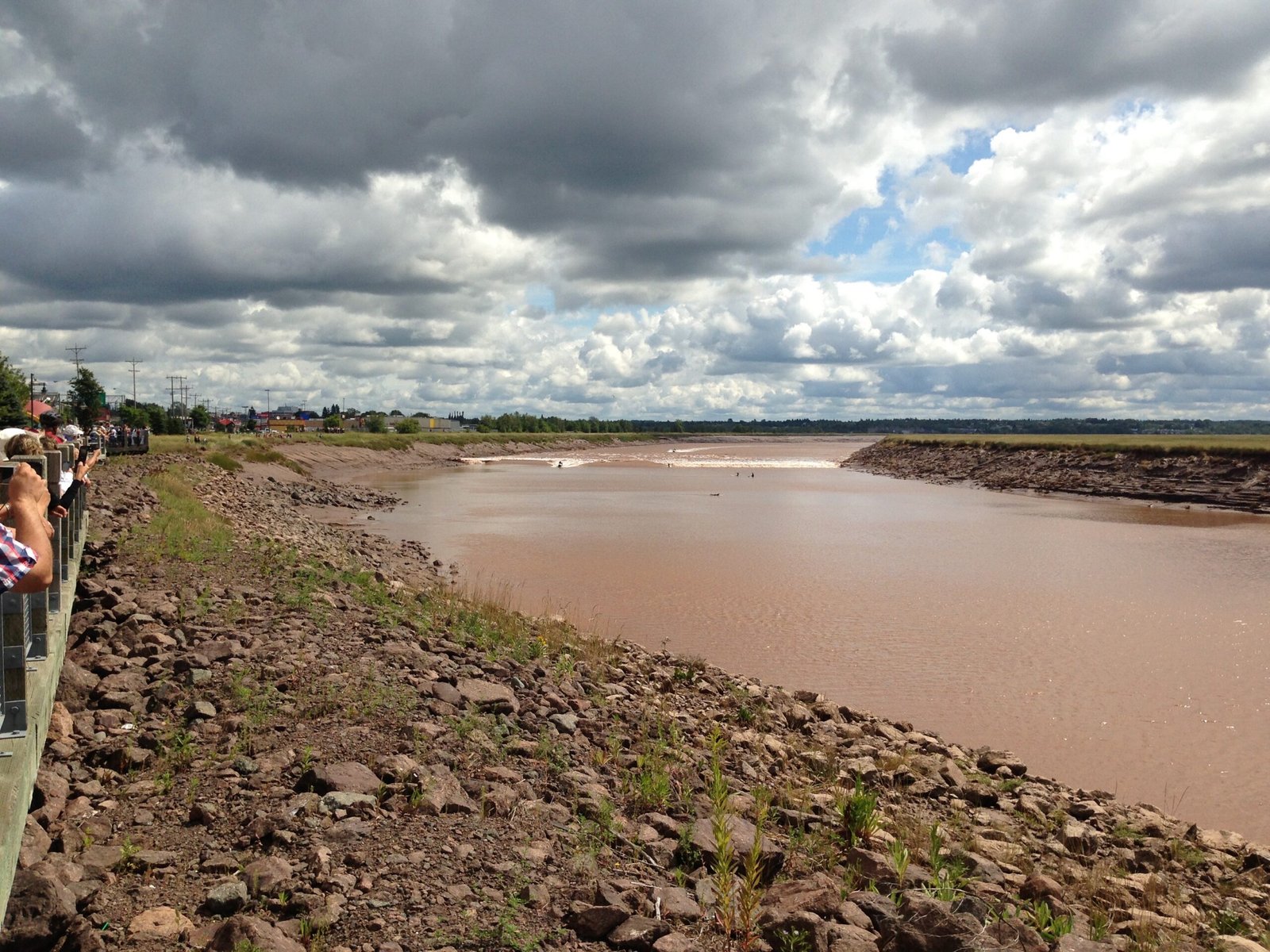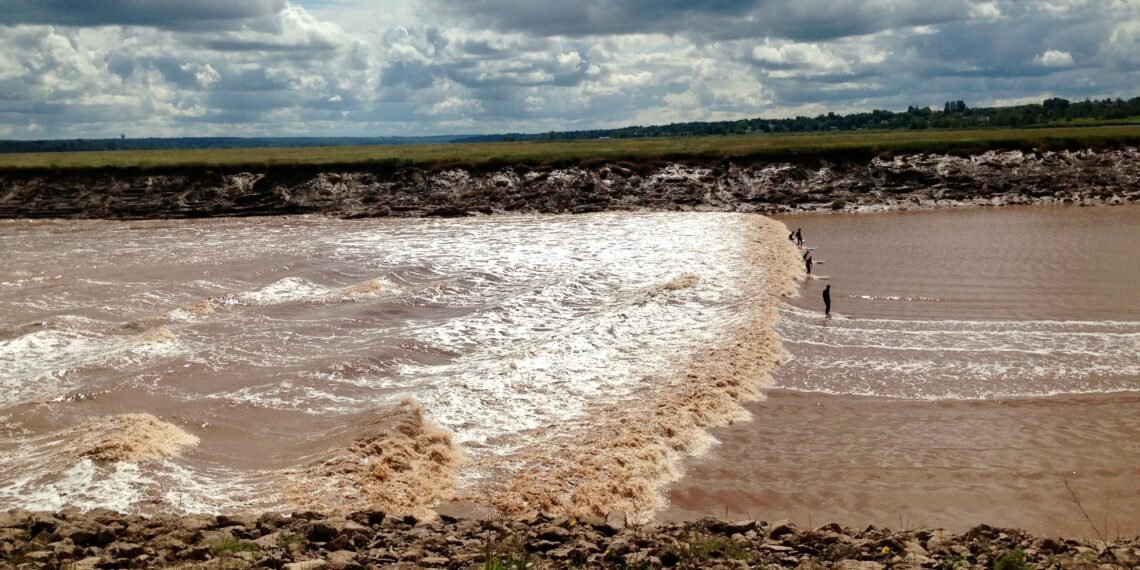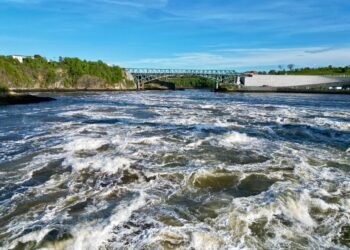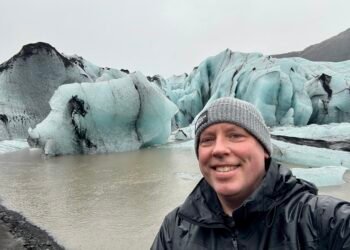Fulfilling a childhood promise, I finally stood on the banks of the Petitcodiac River to witness the Moncton tidal bore—a true wall of Fundy seawater surging upstream through downtown. On one August afternoon, I watched surfers ride a metre-high wave of chocolate-brown water, felt the riverfront boardwalk tremble underfoot, and uncovered the fascinating hydrodynamics, tidal forces, and river restoration efforts that choreograph this daily phenomenon. This story blends that personal thrill with the science behind the Moncton tidal bore—and offers practical insight for anyone itching to see (or surf) it for themselves.
Homecoming on a Moving Tide
It’s often said that we travel far and wide while overlooking the wonders in our own backyard. I was certainly guilty. Growing up in the Maritimes, I treated the natural spectacles that lured tourists east—Fundy’s giant tides, Hopewell’s flowerpot rocks, even Moncton’s famous tidal bore—as background scenery—places I thought of as destinations for tourists, not locals like me. It wasn’t until I relocated to Toronto and booked a summer flight home that I finally penciled the bore onto my “must-see” list.
My itinerary was simple: land at Moncton’s airport late the night before, stay at Chateau Moncton along the riverfront, and check out just before the incoming tide would meet me at lunch. Nature, for once, agreed—the bore was forecast for 12:15 p.m. on a blue-sky Saturday in August.
Quick Facts About the Moncton Tidal Bore:
- Location: Riverfront Park & Bore View Park, Moncton, New Brunswick, Canada
- Wave Height: ~0.5 m – 1 m (1.6 – 3 ft) crest and up to 1.2 m (4 ft) on spring tides)
- Bore Speed: 5 – 13 km/h (3.1 – 8.1 mph)
- Tidal Range: Up to 14 m (46 ft) for the Bay of Fundy
- Frequency: Twice daily (~12 h 25 m apart)
- Best Viewing Months: April – September (largest spring and fall tides)
- Best Vantage: Rail above Riverfront Trail or Bore View Park deck
The River of Chocolate Milk
First light outside my hotel window revealed the Petitcodiac in all its muddy glory. Locals affectionately call it the “Chocolate River,” and from six stories up it looked exactly like a ribbon of thick cocoa winding through tan salt marshes. The colour isn’t pollution; it’s a byproduct of Fundy’s monster tides.
As more than 100 billion tonnes of seawater slam into the shallow estuary twice a day, the incoming surge scours the riverbed, suspending fine silt and turning the surface a latte shade of brown. That same tide also engineers one of Earth’s more curious hydraulic tricks: a tidal bore—a single wall of water that bulldozes upstream against the river’s natural flow.
What Exactly Is a Tidal Bore?
In the simplest terms, a bore is a moving, turbulent hydraulic jump—picture a traveling waterfall turned on its side. Three ingredients must align:
- A tidal range of at least six metres (20 feet).
- A funnel-shaped estuary that narrows inland.
- A broad, shallow riverbed that forces the sea’s momentum upward instead of forward.
The Bay of Fundy supplies the first ingredient in spades; its tides routinely rise 14 metres (46 feet), the highest vertical swing on the planet. The Petitcodiac’s sandbars, once glacial outwash, add the second and third. When the advancing flood meets the outgoing river current, trapped energy resolves itself in a fast-moving wave that can travel 5–13 km/h and lift the river surface by half a metre to a full metre in mere seconds.
A Crowd Gathers at Riverfront Park
By noon I joined a small summer carnival of humanity along the boardwalk by the Chateau Moncton: families fanning themselves with souvenir brochures, lens-toting photographers, and half a dozen wetsuit-clad surfers bobbing in the opaque water below, waiting to hitch a ride upriver.
Only a handful of rivers worldwide host a tidal bore, and Moncton’s is the largest easily accessible one in North America. I first learned about tidal bores years earlier, captivated by a TV documentary showing surfers riding the Pororoca—a roaring tidal wave that travels deep into the Amazon rainforest. Now, standing under the noon heat shimmering off the planks, it struck me how extraordinary it was to witness a similar phenomenon right here at home. The collective hush along the boardwalk felt like a theatre audience moments before curtain.
The White Line—First Sight of the Bore
At 12:13 p.m., a thin, chalk-white seam appeared on the downriver horizon. For an instant I mistook it for glare—then the stripe expanded. The bore’s leading edge stretched bank-to-bank, a crescent of agitated foam bulldozing the placid chocolate river ahead of it. I’d expected a languid creep, something you could stroll beside. Instead, the wave raced toward us in under two minutes, outrunning gulls that tried to hover above its foamy crest.

Adrenaline tickled my knees; the power felt disproportionate to the wave’s one-metre height, as though the whole ocean were breathing through a single exhale.
Surfing the Chocolate Wave
By 12:15 p.m. the wave was right in front of us. The surfers sprang from prone to crouch, noses pointing upriver. It scooped them up like toys, embedding their boards in its muddy shoulder. Cheers erupted from the boardwalk as they glided past—mini‑Mavericks riders in wetsuits splattered with silt instead of salt.

One paddler managed a shaky cutback before the river battered him off his deck; another rode the wave nearly two kilometres (1.2 miles), the bore’s momentum outlasting my sightline. According to local outfitters, an experienced paddler can surf a Fundy bore for upwards of 25 minutes on spring tides.
The Science Beneath the Spectacle
Standing above the churn, I tried to imagine the invisible physics unfolding beneath that opaque skin. Each bore begins as a slight bulge—a tidal wave rushing into narrowing territory. Friction with the riverbed slows the lower layer, steepening the front until it finally overturns into a rolling breaker.
The process is called hydraulic-jump transformation, the same principle engineers harness in spillways to dissipate dam outflows. Yet unlike a stationary dam jump, a bore marches forward, an orphan wave carrying its own steep beach. In cross-section, flow becomes supercritical (faster than the speed of shallow-water gravity waves) ahead of the crest and subcritical behind it—a natural shockwave every paddler can literally ride.
The Bay of Fundy doesn’t express its power in Moncton alone. Just a hundred kilometres southwest, those same tides reverse the flow of the Saint John River in a frothing display known as the Reversing Falls. Farther down the coast, Fundy’s currents collide in Passamaquoddy Bay to create the swirling Old Sow Whirlpool—North America’s largest tidal vortex.
A River Reborn After Half a Century
If I’d made this pilgrimage ten years earlier, the spectacle would have been a disappointment. In 1968 a concrete causeway straddled the Petitcodiac, choking the estuary and reducing the once-majestic bore to a ripple measured in inches.

Photo Credit: Petitcodiac Riverkeepers
Environmental groups fought for decades to reopen the gates, and in 2010 they finally swung ajar. Eleven years later the causeway was demolished and replaced with a bridge, allowing the river to reconnect with Fundy’s pulse. Engineers monitoring the channel noted the bore growing “closer to its pre-1968 levels”—already exceeding early predictions by the first full year of free flow.
Ecology Riding the Wave
Restoring the bore did more than entertain tourists; it rebooted an estuarine ecosystem. As the riverbed scoured clean, tens of thousands of gaspereau and other anadromous fish returned to spawning grounds upstream. Mudflats once starved of oxygen now host invertebrates that fuel migrating shorebirds. Even sediment-loving salt-marsh grasses are recolonizing the banks at a rate scientists hadn’t predicted until the late 2020s.
In a poetic twist, the bore is both a barometer and a catalyst of river health—the bigger the wave, the stronger the estuary, and vice versa.
Practical Tips
Here are some practical tips I picked up during my visit to the Moncton tidal bore to help you make the most of your experience, from timing your arrival to staying safe along the riverside.
- Arrive early: Claim your spot along the boardwalk 20–30 minutes ahead; the crowd thickens fast on weekends and during spring tides.
- Verify the schedule twice: the night before and morning of; atmospheric pressure and strong winds can nudge the bore a few minutes early or late.
- Footwear counts: boardwalks are sneaker-friendly, but if you’ll explore the mudflats after the wave, pack knee-high rubber boots—the silt behaves like wet concrete.
- Dress in layers: a Bay of Fundy sea breeze can drop the temperature 5–10 °C (41-50°F) when the tide rolls in.
- Parking & transit: free lots sit behind Bore View Park; public buses 60 & 61 stop within a 5-minute walk.
- Accessibility: two wheelchair-friendly viewing decks provide unobstructed sightlines and tactile information panels.
- Facilities: public washrooms and water fountains are located 200 m (656 ft) east of the main deck; expect lineups right after the bore.
- Safety first: stay above the high-water line and heed staff flags—bore fronts can undercut banks and create whirlpools.
Pro Tips for the Science Traveler
If you’re keen to dive into the science behind tidal bores and get even more out of your observation at the Moncton tidal bore, these expert tips will enrich your experience.
- Capturing Slow Motion: Shoot slow-motion video (120 fps or higher); step-through playback reveals the rolling hydraulic jump you can’t catch at normal speed.
- Recording a Time-Lapse: Clamp a GoPro to the railing for four hours to record the full 14-metre (46 feet) rise and fall—perfect for classroom demos.
- Talking to Researchers: Speak with watershed researchers from the Petitcodiac Watershed Alliance; they often sample fish after the bore and may be happy to answer questions.
- Pairing Natural Phenomena: Hit Hopewell Rocks at low tide the same day for an ebb-and-flow story arc; measure cliff height versus tidal swing.
- Logging Data Sets: Log the bore’s crest height and speed, then contrast your results with data from other bores, like the Severn (UK) or Qiantang (China) bores.
Beyond the Wave: A City Shaped by Tides
Moncton has woven the bore into its urban fabric. Restaurants time patio seatings to the midday crest; breweries name stouts after the “Chocolate Wave.” Interpretive plaques along the Riverfront Trail explain everything from Mi’kmaq legends to the physics of hydraulic jumps, while a new visitor centre maps the bore’s route against decades of aerial photography.
The city that once turned its back on a muddy trickle now markets it as living theatre—and the crowds prove the strategy is working. On peak summer days, upwards of 1,500 spectators gather for a single tide.
Reflections on a Moving Landmark
Watching the Petitcodiac taught me that a river is never a fixed landmark; it is a living, oscillating suture between land and sea. In twenty minutes, the bore rewrote the river’s flow direction, sediment load—even its colour gradient. By dinner, the tide would retreat, and the river would slouch seaward again, biding its time for round two.
That cyclical resilience feels like an emblem for the Maritimes themselves—buffeted by forces larger than us, yet always ready to surge back.
Stay Curious, Keep Exploring
If you find yourself within striking distance of the Bay of Fundy, carve out time to meet the Chocolate Wave. Stand on the boardwalk, feel the planks tremble as the bore passes, taste the briny spray on an up-river breeze, and let the muddy water remind you that the most extraordinary science travel experiences often hide in the places we once called ordinary.










